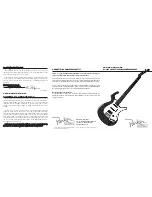
stewmac.com
As was done with the soundboard braces, follow the taper
and shape of the pre-machined back braces and chisel the
ends of each brace to .100" high at the points where they
will notch into the kerfed linings .
KIT TIP: Back brace caul
A notched gluing caul, made from 20" x 3/4" x 1-
1/2" scrap wood or plywood
(pictured)
, can be
placed to one side of the back’s centerline, half
the distance of the spruce center strips . This keeps
the reinforcing center strips in a neat, straight line
from end to end . Use scrap wood cauls and two
cam clamps for uniform pressure on each spruce
strip . Avoid glue squeeze-out that might stick to
the notched caul!
Choose the less attractive side of the joined guitar back as
the inside surface, and transfer the back bracing pattern
from the blueprint to this surface . Place the four braces in
position with their curved surfaces contacting the back,
and notice their more extreme curvature . Unlike the top
gluing setup, a flat surface is not used as a gluing caul for
the back braces . Instead, make a radiused outer gluing caul
by tracing the outer curve of the longest back brace onto a
20" piece of scrap 2" x 4" wood
(illustrated)
. Saw and sand
it to shape . You can make four cauls if you want to glue all
the back braces simultaneously .
After applying glue to a brace, place the caul on the outer
side and clamp the caul and the brace ends first (spring
clamps are useful for this) . Add two cam clamps to reach
the center of the brace .
When all the back braces are installed, trim the spruce center
strips into five pieces of accurate length to cover the cen-
terseam between the back braces . Glue and clamp the center
strips into place and allow to dry before unclamping .
Back bracing and fitting
Installing the back bracing
Fitting the back to the sides
Trace the curved brace onto a 2x4 and cut
on a bandsaw for a curved back-brace caul
If you haven’t yet leveled the back kerfed linings, do so now .
Use the 5° wedged sanding board .
When correctly installed, the guitar’s back will have an arch,
with curvature both longitudinally and laterally, and will
have a slight overhang of about 1/8" around the outside .
Double check that the outside distance of the sides from the
neck block to the tailblock measures the correct 20" body
length . If it doesn’t, the lower bout and tailblock end may
have “stretched” out of shape a little . This can happen if the
assembly sits too long without a top or back, or as a result
of high humidity in your work area . The assembly can be
pulled into length as the back is glued on .
At the neck block end, trim the back’s spruce center strip
until it butts up against the inner edge of the neck block .
The pencil mark should line up at the front edge of the guitar
at the neck block . Be sure the penciled back outline at the
tailblock end is also exactly 20" from the neck block mark .
Place the guitar’s back assembly onto the rim assembly,
align the center seam with the side seams, butt the trimmed
spruce reinforcing strip up against the neck block, and dry
clamp lightly . Next, carefully and lightly dry-clamp the
tailblock end of the back, making sure that the body length
pencil mark aligns with the sides, and that the centerlines
match . If the sides at the tailblock don’t align with the body
length pencil mark on the back, gently push the sides and
tailblock slightly until the body length mark meets the sides,
and lightly dry-clamp . You may find it easier to have a friend
help in case you need to manipulate the neck block and
tailblock into shape .
Use a white pencil to mark the positions of the ends of the
12
Summary of Contents for 5295
Page 1: ...Dreadnought Acoustic Guitar Kit 5295 Assembly Instructions www stewmac com ...
Page 2: ......
Page 39: ......


































